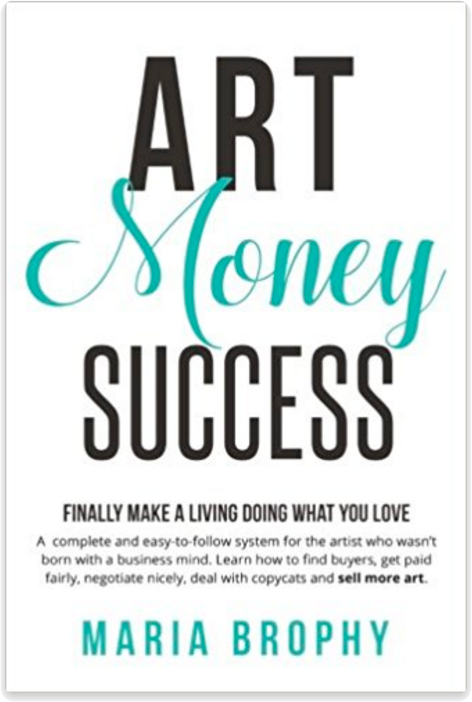I’m going to share a secret with you – you can get PAID for your charitable contributions!
Artists are constantly asked to give art to schools, charities, and even profitable companies.
Yes, giving feels great! But, many artists are giving too much and it creates a financial hardship for them.
If you are an artist that is giving too much, this post will forever change your perspective! I’m going to give you strategies to handle charity requests that will result in an increase in your income!
(You might even send me a virtual “high five” after you read this.)
HOW TO TURN A CHARITY REQUEST FOR FREE ART INTO A PAID SALE
Artists, photographers, musicians, writers; we make what we do look too easy.
Maybe that’s why our friends, family and even strangers ask us to donate much of our valuable time and art, not realizing that this is what we do for a living.
Some artists donate so much that it harms their family, their future, and can eventually put them out of business. (Art supplies, framing, studio rent, etc. is not free!)
I know of one professional artist who has given so much of his work away, he can no longer afford a car or properly provide for his own son. It breaks my heart to see an artist believe they are being generous, yet their own children suffer!
It doesn’t have to be this way.
In this post I’ll share my thoughts on:
- Why giving Money is better than giving Art
- How the promise of “Promoting your Art” is bogus
- WHY a charity will PAY you even if they want it for free
- How to get paid for Art for a charity Auction or Illustration/Design
- SCRIPTS – 2 examples of my personal scripts for handling charity requests
If you implement these strategies, you’ll increase your sales by turning “Free into Paid” opportunities, AND you’ll still be that generous, loving person that you want to be.
GIVING IS GOOD; DO IT MINDFULLY
Your brother’s wife’s cousin calls for a donation for her charity auction. How can you say “no”? It’s so hard! But, when you receive requests, almost daily (like we do), it can wear on you and the health of your business.
Drew and I get barraged with requests through Facebook, e-mail and some people even walk into the studio while my husband Drew is painting. They stop him from working on a client’s project so that they can tell him about their charity and how he can give to them!
If you’ve been a professional artist for more than 5 years, this is happening to you regularly. If it’s not happening to you yet, it will, trust me.
BUT WAIT: ISN’T GIVING NOBLE?!
I have to stop for a moment and share my philosophy on giving to charities and good causes, because if I don’t, someone is going to write and say “don’t be selfish, Maria! Be more giving!”
Yes, giving is noble. Taking from your child’s future to give to strangers is not! That’s why Drew and I pay a % of our income to three of our favorite charities each year. We mindfully plan out how we will help the causes that are near and dear to our hearts.
We all should be generous and help charitable causes, mindfully and in a way that doesn’t harm our business or family.
WHY MONEY IS A BETTER DONATION THAN ART
Artists often forget how much their art, time, materials, blood sweat and tears, are worth. When you get to a point where you are giving, giving, giving, you lose track of how much it’s really costing you as an artist. Giving money, instead of art, can be better for you because:
1 – Easily Tracked: Donating money rather than art is more easily tracked and controlled. Drew and I tithe our income for causes that we care about. We choose to give money rather than art, mostly because our favorite charities need money more than art. But, also, we give money because it’s a sensible write-off on taxes.
2 – I.R.S. rules do not favor artists: If you donate $1,500 cash, the IRS gives you a $1,500 write off. However, if you donate a $1,500 painting, the IRS only allows you to write off your actual cost of materials; YOU CANNOT WRITE OFF the value of the two weeks that it took to paint it.
3 – It’s Prudent: It makes greater financial sense to give money rather than art. That being said, there are ways to “donate” art to a good cause, while still being paid.
DONATING YOUR ART IN EXCHANGE FOR PROMOTION: BOGUS?!
How many times have you heard the line “but it will be great promotion for you!”
Years ago we donated often, freely, for many different charity events. It cost us a lot of time and money, but we were drawn in, wanting to contribute to others. We also thought the promotional aspect that the charities promised could be good for our business.
Over time, we realized that we never got new, paying clients directly from a charitable donation. What we did get, though, were more and more requests to donate art!
The idea that giving art away is going to get you more business is false. If you are donating for promotional purposes, you’re doing it for the wrong reasons.
HOW CHARITIES WORK AND WHY THEY WILL PAY FOR YOUR ART EVEN IF THEY WANT IT FOR FREE:
When a charity asks me for a donation, I get excited, because now I see it as an opportunity to sell art and to connect with a new potential client!
I turn their request into a sale.
Charitable organizations are run like any other business; they have a product (their promise), a vision and a brand. Just like other businesses, they need a logo and design, a lawyer and a website. And if they want these things done right, they have to pay for them.
When an organization approaches you for a donation, turn it into a sale!
If it’s an auction item they want, offer:
1 – To sell your art to them at a wholesale price (payable at delivery) or;
2 – Your art in exchange for a 50/50 split of the auction proceeds.
Some charities will tell you that their by-laws don’t allow for a split of auction; in this case, then a wholesale price will have to do. The discount off the retail price is your donation to the charity.
If it’s a design or illustration, take the time to find out what they need; get a good understanding of their problem and then put together a proper proposal.
Tell them that you are happy to offer a 10% or 20% discount off your normal rate; this is your donation. (For example, a $2,000 project discounted at 20% = a $400 donation. This is a very generous donation!)
Oh, they say they want it only if it’s free? Most businesses find out quickly that going to an artist with little to no experience, one who charges $0, will not get them what they need.
If they need logo, web or design services, they will be sadly disappointed going to someone who doesn’t charge. The work most likely won’t be done, and if it is, it will be of low quality.
If they want art that will sell at auction and raise top dollar for their charity, they need quality art.
To get the best art from an artist, they will have to pay for it.
Artists who don’t charge charities often donate an old, dusty piece that they couldn’t sell themselves. This is not the best way to make a good impression at an auction. (Read my full explanation of this phenomena of artists giving bad art to charities here.)
Don’t feel bad about charging charities for your work! (Everyone else is getting paid, and they don’t feel bad about it.)
The employees at the charities don’t feel bad cashing their paychecks, nor do their attorneys feel remorse for charging them legal fees, nor does their printer, their landlord, and all of their other vendors.
If the charity does not accept your proposal or your offer, that’s okay, let it go. Out of the many charities that contact us, only about 60% actually buy from us. The rest of them find artists who are willing to give art away.
MY OWN STORY – WHEN A GOOD FRIEND ASKED FOR FREE DESIGN FOR THEIR CHARITY:
A few years ago a very dear friend of mine asked Drew to create an illustration package for his charity. They needed logo treatments, a full illustration, and tee shirt designs. It was going to take Drew at least four to five weeks from start to finish.
I was excited and said “Thank you so much for the opportunity! I’ll work up a proposal for you.”
He said, “Oh, we were hoping Drew would do it for free.”
My enthusiasm dropped like an lead balloon! I explained to my friend “What you are asking for is an entire month’s income from us.”
He countered, “But thousands of people will see the art. It will be great promotion for you!”
I jokingly suggested, “Why don’t you just donate a month of your income to the charity, and that can pay for the art.”
He went silent. This helped to put it into perspective for him. And then he said, apologetically, “Wow, I never looked at it like that.”
I gave them a proposal that offered a “donation” of a price break (20% off our typical charge for an illustration package).
I told them that if the charity decided not to accept our proposal, we would understand, and would help them find a young illustrator who was still learning, who would charge less.
A week later, my friend called to say that the charity accepted our proposal. They decided not to use a cheaper, inexperienced illustrator, because this project was going to be highly publicized and it had to look professional.
Drew completed the project, and it was a win-win for everyone.
I didn’t lose a friend for saying “no freebies” and I didn’t put my business (and my family) in jeopardy by giving away a month’s income.
Instead, we gave a “donation” via a 20% discount to a good charity, the client was happy AND we got paid. It worked out great for all involved; win-win-win!
SCRIPTS FOR REQUESTS FOR FREE ART:
From now on, when you get a request to donate your art, instead of thinking “oh no, not again,” see it as an opportunity to put these ideas into practice!
When you respond to someone with confidence, such as “Here’s what we offer to charities…” their response will be one of respect and understanding.
Here are a few scripts that I keep in my Art Business Tool Box:
Script #1 – Turn their Request for Auction Artwork into a Sale:
Scenario: Charity requests a piece of art that will be auctioned at a live event.
Script: “Thank you for your interest in my art! I am happy to provide a high value art piece for your event, so that you can generate profit as well as impress your attendees. This is how I work with charities; I’m able to donate 40% of the retail price of the art piece you choose. The other 60% will be payable to me at pickup or delivery. Any money your charity earns over the 60% that you pay is all yours. Fair enough?”
Send them options to choose from, with their pricing. Make sure you’re paid at pickup/delivery, or have them sign an invoice that says they will pay within 7 days of auction.
This works! We used to give art to a black-tie event year after year. Finally, a few years ago, I told them they had to pay wholesale. I thought they would say “no”, but, instead, they brought me a check, and continue to buy art from us every year.
GIFT CERTIFICATE is your next best option: If the charity says “no thank you, we don’t have a budget to purchase art” your next option is to offer a Gift Certificate, not an actual art piece.
For example, a gift certificate that reads: “This certificate gives the holder $50 off of any art piece over $500.”
This way, the charity earns their money off the auction, and you gain a new art buyer and a sale, when the buyer comes to cash in their certificate.
Script #2 – Turn their Request for Free Design/Illustration Work into a Sale:
Scenario: Charity requests design/illustration work for an upcoming event or a business need.
Script: “Thank you for your interest in working with me. I appreciate the opportunity! Can you tell me a little more about what you need?” (This is asked so you can assess what they need and then you can put together a detailed proposal that shows how you can solve their design problems.)
Ask questions so that you gain an understanding of what their problem or challenge is and what their desired result is.
Then say: “Thanks for the detail. I am confident I can create art to meet your needs.” (Explain HOW you can get them the results they need.)
“Your charity is doing important work, and so I’d like to make a donation that’s equal to 10% of the cost of the work. Let’s do this; I’ll write up a proposal and send it to you and we can go from there. Sound good?”
The above script establishes two things:
1 – that you recognize how important their charity is, and that you are willing to donate in the form of a discount, and;
2 – that you expect them to pay you for your services.
Setting up the expectation changes the dynamic of future communications!
Your proposal should then show the total cost, and then indicate the discount (donation) that you offer, and a total after that amount is deducted.
WHAT DO YOU THINK? Often, I bring up this topic and get mixed comments from artists; many saying that they have been drained dry from giving too much to charities. Other artists argue that they want to give their art away. (And that’s totally okay, as long as it’s not draining you, harming your family or killing your business!)
I’m writing this not to sway you from giving generously! My intention is to help those artists who did not know that they can ASK TO BE PAID and they are still being generous even when giving a discounted price.
PLEASE, SHARE IN THE COMMENTS, your experiences with giving to charities and how it has helped or hurt your business. I’d love to hear your take on it!
Maria xxoo
















71 Responses
My most relative experience with giving away art happened 2 years ago when a school asked me to spray paint a space galaxy mural in one of the bathroom stalls.
Me being new and inexperienced on how to do business with my art, I agreed and ended up doing it all for free (although when she saw the finished work the principal did give me a $10 gift card as a tip ;)).
Gosh, I wish I had seen this article sooner!
But thankfully the work took only a few hours to do in the afternoon, didn’t use up too much paint and at least my art brightened up the days of many kids at the school.
Bedankt voor het delen van zulke goede informatie over fondsenwerving